SALON: Simplified Sensing System for Activity of Daily Living in Ordinary Home
Abstract
:1. Introduction
- First, we constructed a sensing system that fulfills Reqs. (i)–(v) by assuming that the system would be used by typical elderly people. Because our proposed system consists of energy harvesting sensors, long-term driven environmental sensors, and simple annotation pushbuttons, it is senior-friendly and does not violate user privacy. The use of maintenance-free sensors allows for long-term data collection (Reqs. (i), (iii), and (iv)). Additionally, because the proposed system is not affected by residence floor plans, it can be easily installed in a wide variety of different homes (Req. (ii)). Additionally, the resident’s burden for annotation can be reduced by using simple pushbuttons unlike existing works such as CASAS SHiB or Kasteren’s system that use complicated software or wearable mic devices for annotation (Req. (v)). Through installation and operation in ten typical homes occupied by elderly residents, we confirmed that our proposed system fulfills Reqs. (i)–(v). Furthermore, we confirmed that our proposed system could correctly collect ADL data by visualizing the relationships between the ADL and sensor data that were collected during the experiment.
- Second, we analyzed in-the-wild ADL data collected by our proposed system in typical homes and confirmed that it could recognize activities at a recall rate of approximately 72%.
2. Related Work
2.1. ADL Sensing System Requirements for Homes of Typical Elderly People
- Req. (i):
- It should be inexpensive.
- Req. (ii):
- It should not be affected by installation locations or residence floor plans.
- Req. (iii):
- It should generally protect user privacy.
- Req. (iv):
- It should operate maintenance-free for long periods of time.
- Req. (v):
- It should have a simple user interface that can be easily annotated by elderly people.
2.2. Activity Recognition Systems Used in Living Spaces
2.3. ADL Sensing System for Restricted Environment
2.4. ADL Sensing System in General Environments
2.5. Position of Our Study
3. Proposed System
3.1. System Design
- Motion sensors (energy harvesting)
- Ambient sensors that collect temperature, humidity, illuminance, pressure, and noise information
- Magnetic door sensors (energy harvesting)
- Pushbuttons for annotation (energy harvesting)
- Data server (small PC)
3.2. System Configuration
3.2.1. Motion Sensors
3.2.2. Ambient Sensors
3.2.3. Door Sensor
3.2.4. Annotation Pushbutton
3.2.5. Data Server
4. Data Collection Experiment
4.1. Experimental Objective
4.2. Experimental Process
4.3. Experimental Target
4.4. Installation of the Proposed System
- Motion Sensor: We prepared a maximum of ten for each home and installed no more than one in each room, where they were arranged to provide the maximum coverage, in order to reduce the number of motion sensors. However, in some cases, some rooms did not have sensors. The contact surface of the sensors was protected by masking tape, and each device was fixed to a wall with double-sided tape (Figure 2). This process made it easy to install and remove the sensors without damaging the wall surface. Each sensor was placed at a height of 1 m from the floor in order to be clear of obstacles, such as furniture and curtains. This installation procedure also ensured that the sensor would react to people while avoiding pets and home appliances that could cause false activations.
- Ambient Sensor: Ambient sensors were emplaced in optional locations at a height of 1 m from the floor in the same manner (and in most cases adjacently to) the motion sensors (Figure 2). The sampling interval was set at 3 min. (1/180 Hz) in consideration of the trade-off between the experimental period and the battery life. In our preliminary experiment, we had confirmed that the sensor could operate continuously at this sampling rate over a period of three months.
- Door Sensor: Door sensors were installed at the entrance and bathroom doors using the same procedure that was described for the motion sensor. The main body of the sensor was installed on the door, and the magnet was installed on the door frame (Figure 3).
- Annotation Pushbutton: In this experiment, five activities (“bathing,” “cooking,” “eating”, “going out”, and “sleeping”) were selected as sensing targets. Therefore, five annotation button sets were placed in each home. The installation locations were chosen to make it as easy as possible for the participants to push the proper annotation button at the correct times. For instance, the annotation button for “cooking” was placed near the kitchen, and the annotation button for “sleeping” was placed near the bed. The participants were instructed to push the start/end switches at the start/end times of the target activities. In addition to using the annotation buttons, the residents were asked to fill in daily questionnaires (Figure 4) at the end of the day to annotate their ADL activities. In the questionnaire, the residents were asked to confirm whether they performed each activity and whether they had remembered to push the annotation buttons appropriately.
- Data Server: To maintain high strength communication levels, the data server was placed in an unobstructed location, such as under a sofa in the center room of the home (Figure 5).
4.5. Data Collection Results
5. Analysis of Activity Recognition
5.1. Data Shaping
5.2. Handling Missing Values
- (Type 1)
- Forgetting to push both start and end buttons.
- (Type 2)
- Forgetting to push the start button.
- (Type 3)
- Forgetting to push the end button.
- (Step 1)
- Modify the activity data based on the questionnaire (corresponding to Types 1 to 3)
- (Step 2)
- Generate the start instance from independent end data using the average time of target activity (corresponding to Type 2)
- (Step 3)
- Generate the end instance from independent start data using the average time of target activity (corresponding to Type 3)
5.3. Algorithm for Activity Recognition
5.4. Evaluation Method
5.5. Activity Recognition Results
6. Discussion and Limitation
6.1. Discussion
6.2. Limitation
6.3. Comparison with Related Work
6.3.1. Concept
6.3.2. Sensor Installation
6.3.3. Annotation
6.3.4. Target Activities
6.3.5. Environment/Data
6.3.6. Result of Activity Recognition
7. Conclusions
Author Contributions
Funding
Conflicts of Interest
References
- World Health Organization: Sustainable Development Goals. Available online: https://www.who.int/sdg/en/ (accessed on 25 May 2020).
- Lasi, H.; Fettke, P.; Kemper, H.G.; Feld, T.; Hoffmann, M. Industry 4.0. Bus. Inf. Syst. Eng. 2014, 6, 239–242. [Google Scholar] [CrossRef]
- Cabinet Office: The 5th Science and Technology Basic Plan. Available online: https://www8.cao.go.jp/cstp/kihonkeikaku/5basicplan_en.pdf (accessed on 25 May 2020).
- Cabinet Office: Annual Report on the Aging Society. Available online: https://www8.cao.go.jp/kourei/english/annualreport/2017/2017pdf_e.html (accessed on 25 May 2020).
- Aran, O.; Sanchez-Cortes, D.; Do, M.T.; Gatica-Perez, D. Anomaly detection in elderly daily behavior in ambient sensing environments. In International Workshop on Human Behavior Understanding; Springer: Berlin/Heidelberg, Germany, 2016; pp. 51–67. [Google Scholar]
- Alcalá, J.M.; Ureña, J.; Hernández, Á.; Gualda, D. Assessing human activity in elderly people using non-intrusive load monitoring. Sensors 2017, 17, 351. [Google Scholar] [CrossRef] [PubMed]
- De, D.; Bharti, P.; Das, S.K.; Chellappan, S. Multimodal wearable sensing for fine-grained activity recognition in healthcare. IEEE Internet Comput. 2015, 19, 26–35. [Google Scholar] [CrossRef]
- Van Kasteren, T.; Noulas, A.; Englebienne, G.; Kröse, B. Accurate activity recognition in a home setting. In Proceedings of the 10th International Conference on Ubiquitous Computing, Seoul, Korea, 21–24 September 2008; ACM: New York, NY, USA, 2008; pp. 1–9. [Google Scholar]
- Alemdar, H.; Ertan, H.; Incel, O.D.; Ersoy, C. ARAS human activity datasets in multiple homes with multiple residents. In Proceedings of the 2013 7th International Conference on Pervasive Computing Technologies for Healthcare and Workshops (PervasiveHealth 2013), Venice, Italy, 5–8 May 2013; pp. 232–235. [Google Scholar]
- Lago, P.; Lang, F.; Roncancio, C.; Jiménez-Guarín, C.; Mateescu, R.; Bonnefond, N. The ContextAct@ A4H real-life dataset of daily-living activities. In International and Interdisciplinary Conference on Modeling and Using Context; Springer: Berlin/Heidelberg, Germany, 2017; pp. 175–188. [Google Scholar]
- De Miguel, K.; Brunete, A.; Hernando, M.; Gambao, E. Home camera-based fall detection system for the elderly. Sensors 2017, 17, 2864. [Google Scholar] [CrossRef] [PubMed] [Green Version]
- Tapia, E.M.; Intille, S.S.; Larson, K. Activity recognition in the home using simple and ubiquitous sensors. In International Conference on Pervasive Computing; Springer: Berlin/Heidelberg, Germany, 2004; pp. 158–175. [Google Scholar]
- Domus Laboratory: Smart Environment Dataset. Available online: https://www.usherbrooke.ca/domus/en/research/dataset/ (accessed on 25 May 2020).
- Vacher, M.; Lecouteux, B.; Chahuara, P.; Portet, F.; Meillon, B.; Bonnefond, N. The Sweet-Home speech and multimodal corpus for home automation interaction. In Proceedings of the Ninth International Conference on Language Resources and Evaluation (LREC’14), Reykjavik, Iceland, 26–31 May 2014; European Language Resources Association (ELRA): Reykjavik, Iceland, 2014; pp. 4499–4506. [Google Scholar]
- Cook, D.J.; Crandall, A.S.; Thomas, B.L.; Krishnan, N.C. CASAS: A smart home in a box. Computer 2012, 46, 62–69. [Google Scholar] [CrossRef] [Green Version]
- Steele, R.; Lo, A.; Secombe, C.; Wong, Y.K. Elderly persons’ perception and acceptance of using wireless sensor networks to assist healthcare. Int. J. Med. Inform. 2009, 78, 788–801. [Google Scholar] [CrossRef]
- Ohnishi, K.; Kanehira, A.; Kanezaki, A.; Harada, T. Recognizing activities of daily living with a wrist-mounted camera. In Proceedings of the IEEE Conference on Computer Vision and Pattern Recognition (CVPR’16), Las Vegas, NV, USA, 26–30 June 2016; pp. 3103–3111. [Google Scholar]
- Filippoupolitis, A.; Takand, B.; Loukas, G. Activity recognition in a home setting using off the shelf smart watch technology. In Proceedings of the 2016 15th International Conference on Ubiquitous Computing and Communications and 2016 International Symposium on Cyberspace and Security (IUCC-CSS), Granada, Spain, 14–16 December 2016; pp. 39–44. [Google Scholar]
- Kashimoto, Y.; Fujiwara, M.; Fujimoto, M.; Suwa, H.; Arakawa, Y.; Yasumoto, K. ALPAS: Analog-PIR-sensor-based activity recognition system in smarthome. In Proceedings of the 2017 IEEE 31st International Conference on Advanced Information Networking and Applications (AINA), Taipei, Taiwan, 27–29 March 2017; pp. 880–885. [Google Scholar]
- Wang, J.; Chen, Y.; Hao, S.; Peng, X.; Hu, L. Deep learning for sensor-based activity recognition: A survey. Pattern Recognit. Lett. 2019, 119, 3–11. [Google Scholar] [CrossRef] [Green Version]
- Ordóñez, F.J.; Roggen, D. Deep convolutional and lstm recurrent neural networks for multimodal wearable activity recognition. Sensors 2016, 16, 115. [Google Scholar] [CrossRef] [Green Version]
- Roy, N.; Misra, A.; Cook, D. Ambient and smartphone sensor assisted ADL recognition in multi-inhabitant smart environments. J. Ambient Intell. Humaniz. Comput. 2016, 7, 1–19. [Google Scholar] [CrossRef] [Green Version]
- Wan, J.; O’grady, M.J.; O’hare, G.M. Dynamic sensor event segmentation for real-time activity recognition in a smart home context. Pers. Ubiquitous Comput. 2015, 19, 287–301. [Google Scholar] [CrossRef]
- Fafoutis, X.; Janko, B.; Mellios, E.; Hilton, G.; Sherratt, R.S.; Piechocki, R.; Craddock, I. SPW-1: A low-maintenance wearable activity tracker for residential monitoring and healthcare applications. In eHealth 360°; Springer: Berlin/Heidelberg, Germany, 2017; pp. 294–305. [Google Scholar]
- Chernbumroong, S.; Cang, S.; Atkins, A.; Yu, H. Elderly activities recognition and classification for applications in assisted living. Expert Syst. Appl. 2013, 40, 1662–1674. [Google Scholar] [CrossRef]
- Wang, Y.; Liu, J.; Chen, Y.; Gruteser, M.; Yang, J.; Liu, H. E-eyes: Device-free location-oriented activity identification using fine-grained wifi signatures. In Proceedings of the 20th Annual International Conference on Mobile Computing and Networking (MobiCom 2014), Maui, HI, USA, 7–11 September 2014; pp. 617–628. [Google Scholar]
- Wang, W.; Liu, A.X.; Shahzad, M.; Ling, K.; Lu, S. Understanding and modeling of wifi signal based human activity recognition. In Proceedings of the 21st Annual International Conference on Mobile Computing and Networking (MobiCom 2015), Paris, France, 7–11 September 2015; pp. 65–76. [Google Scholar]
- Pu, Q.; Gupta, S.; Gollakota, S.; Patel, S. Whole-home gesture recognition using wireless signals. In Proceedings of the 19th Annual International Conference on Mobile Computing & Networking (MobiCom 2013), Miami, FL, USA, 30 September–4 October 2013; pp. 27–38. [Google Scholar]
- Kellogg, B.; Talla, V.; Gollakota, S. Bringing gesture recognition to all devices. In Proceedings of the 11th USENIX Symposium on Networked Systems Design and Implementation (NSDI’14), Seattle, WA, USA, 2–4 April 2014; pp. 303–316. [Google Scholar]
- Buettner, M.; Prasad, R.; Philipose, M.; Wetherall, D. Recognizing daily activities with RFID-based sensors. In Proceedings of the 11th International Conference on Ubiquitous Computing (UbiComp’09), Orlando, FL, USA, 30 September–3 October 2009; pp. 51–60. [Google Scholar]
- Fortin-Simard, D.; Bilodeau, J.S.; Bouchard, K.; Gaboury, S.; Bouchard, B.; Bouzouane, A. Exploiting passive RFID technology for activity recognition in smart homes. IEEE Intell. Syst. 2015, 30, 7–15. [Google Scholar] [CrossRef]
- Wang, L.; Gu, T.; Tao, X.; Chen, H.; Lu, J. Recognizing multi-user activities using wearable sensors in a smart home. Pervasive Mob. Comput. 2011, 7, 287–298. [Google Scholar] [CrossRef]
- Kashimoto, Y.; Morita, T.; Fujimoto, M.; Arakawa, Y.; Suwa, H.; Yasumoto, K. Sensing activities and locations of senior citizens toward automatic daycare report generation. In Proceedings of the 2017 IEEE 31st International Conference on Advanced Information Networking and Applications (AINA), Taipei, Taiwan, 27–29 March 2017; pp. 174–181. [Google Scholar]
- Morita, T.; Taki, K.; Fujimoto, M.; Suwa, H.; Arakawa, Y.; Yasumoto, K. Beacon-Based Time-Spatial Recognition toward Automatic Daily Care Reporting for Nursing Homes. J. Sens. 2018, 2018, 2625195. [Google Scholar] [CrossRef] [Green Version]
- Lotfi, A.; Langensiepen, C.; Mahmoud, S.M.; Akhlaghinia, M.J. Smart homes for the elderly dementia sufferers: Identification and prediction of abnormal behaviour. J. Ambient Intell. Humaniz. Comput. 2012, 3, 205–218. [Google Scholar] [CrossRef]
- Suryadevara, N.; Gaddam, A.; Rayudu, R.; Mukhopadhyay, S. Wireless sensors network based safe home to care elderly people: Behaviour detection. Sens. Actuators A Phys. 2012, 186, 277–283. [Google Scholar] [CrossRef]
- Thomaz, E.; Bettadapura, V.; Reyes, G.; Sandesh, M.; Schindler, G.; Plötz, T.; Abowd, G.D.; Essa, I. Recognizing water-based activities in the home through infrastructure-mediated sensing. In Proceedings of the 2012 ACM Conference on Ubiquitous Computing (UbiComp’12), Pittsburgh, PA, USA, 5–8 September 2012; pp. 85–94. [Google Scholar]
- Guyot, P.; Pinquier, J.; André-Obrecht, R. Water sound recognition based on physical models. In Proceedings of the 2013 IEEE International Conference on Acoustics, Speech and Signal Processing (ICASSP 2013), Vancouver, BC, Canada, 26–31 May 2013; pp. 793–797. [Google Scholar]
- Nakagawa, E.; Moriya, K.; Suwa, H.; Fujimoto, M.; Arakawa, Y.; Yasumoto, K. Toward real-time in-home activity recognition using indoor positioning sensor and power meters. In Proceedings of the 2017 IEEE International Conference on Pervasive Computing and Communications Workshops (PerCom Workshops), Kona, HI, USA, 13–17 March 2017; pp. 539–544. [Google Scholar]
- Yassine, A.; Singh, S.; Alamri, A. Mining human activity patterns from smart home big data for health care applications. IEEE Access 2017, 5, 13131–13141. [Google Scholar] [CrossRef]
- Ueda, K.; Suwa, H.; Arakawa, Y.; Yasumoto, K. Exploring accuracy-cost tradeoff in in-home living activity recognition based on power consumptions and user positions. In Proceedings of the 2015 IEEE International Conference on Computer and Information Technology; Ubiquitous Computing and Communications; Dependable, Autonomic and Secure Computing; Pervasive Intelligence and Computing, Liverpool, UK, 26–28 October 2015; pp. 1130–1137. [Google Scholar]
- Sasaki, W.; Fujiwara, M.; Suwa, H.; Fujimoto, M.; Arakawa, Y.; Kimura, A.; Miki, T.; Yasumoto, K. Daily Living Activity Recognition through Time Series Analysis of Data Obtained with ECHONET Lite Appliances and Motion Sensors. SIG-SAI 2018, 31, 1–8. (In Japanese) [Google Scholar]
- Moriya, K.; Nakagawa, E.; Fujimoto, M.; Suwa, H.; Arakawa, Y.; Kimura, A.; Miki, S.; Yasumoto, K. Daily living activity recognition with echonet lite appliances and motion sensors. In Proceedings of the 2017 IEEE International Conference on Pervasive Computing and Communications Workshops (PerCom Workshops), Kona, HI, USA, 13–17 March 2017; pp. 437–442. [Google Scholar]
- Lin, H.; Bergmann, N.W. IoT privacy and security challenges for smart home environments. Information 2016, 7, 44. [Google Scholar] [CrossRef] [Green Version]
- Maldonado, M.G.R. Wireless Sensor Network for Smart Home Services Using Optimal Communications. In Proceedings of the 2017 International Conference on Information Systems and Computer Science (INCISCOS), Quito, Ecuador, 23–25 November 2017; pp. 27–32. [Google Scholar]
- Chitnis, S.; Deshpande, N.; Shaligram, A. An investigative study for smart home security: Issues, challenges and countermeasures. Wirel. Sens. Netw. 2016, 8, 61. [Google Scholar]
- Chhaya, L.; Sharma, P.; Bhagwatikar, G.; Kumar, A. Wireless sensor network based smart grid communications: Cyber attacks, intrusion detection system and topology control. Electronics 2017, 6, 5. [Google Scholar] [CrossRef]
- Salman, A.D.; Khalaf, O.I.; Abdulsahib, G.M. An adaptive intelligent alarm system for wireless sensor network. Indones. J. Electr. Eng. Comput. Sci. 2019, 15, 142–147. [Google Scholar] [CrossRef]
- Pirbhulal, S.; Zhang, H.; E Alahi, M.; Ghayvat, H.; Mukhopadhyay, S.; Zhang, Y.T.; Wu, W. A novel secure IoT-based smart home automation system using a wireless sensor network. Sensors 2017, 17, 69. [Google Scholar] [CrossRef]
- Twomey, N.; Diethe, T.; Craddock, I.; Flach, P. Unsupervised learning of sensor topologies for improving activity recognition in smart environments. Neurocomputing 2017, 234, 93–106. [Google Scholar] [CrossRef] [Green Version]
- WSU CASAS Datasets. Available online: http://casas.wsu.edu/datasets/ (accessed on 25 May 2020).
- Hu, Y.; Tilke, D.; Adams, T.; Crandall, A.S.; Cook, D.J.; Schmitter-Edgecombe, M. Smart home in a box: Usability study for a large scale self-installation of smart home technologies. J. Reliab. Intell. Environ. 2016, 2, 93–106. [Google Scholar] [CrossRef] [Green Version]
- Diethe, T.; Holmes, M.; Kull, M.; Perello Nieto, M.; Sokol, K.; Song, H.; Tonkin, E.; Twomey, N.; Flach, P. Releasing ehealth analytics into the wild: Lessons learnt from the sphere project. In Proceedings of the 24th ACM SIGKDD International Conference on Knowledge Discovery & Data Mining (KDD’18), London, UK, 19–23 August 2018; pp. 243–252. [Google Scholar]
- McConville, R.; Archer, G.; Craddock, I.; Kozłowski, M.; Piechocki, R.; Pope, J.; Santos-Rodriguez, R. Vesta: A digital health analytics platform for a smart home in a box. Future Gener. Comput. Syst. 2020, 114, 106–119. [Google Scholar] [CrossRef]
- InfluxDB. Available online: https://www.influxdata.com/ (accessed on 25 May 2020).
- ngrok. Available online: https://ngrok.com/ (accessed on 25 May 2020).
- Matsui, T.; Onishi, K.; Shinya, M.; Fujimoto, M.; Suwa, H.; Yasumoto, K. Easy-to-Deploy Living Activity Sensing System and Data Collection in General Homes. In Proceedings of the 2020 IEEE International Conference on Pervasive Computing and Communications Workshops (PerCom Workshops), Austin, TX, USA, 23–27 March 2020; pp. 460–465. [Google Scholar]
- Chawla, N.V.; Bowyer, K.W.; Hall, L.O.; Kegelmeyer, W.P. SMOTE: Synthetic minority over-sampling technique. J. Artif. Intell. Res. 2002, 16, 321–357. [Google Scholar] [CrossRef]
- Ye, J.; Dobson, S.; McKeever, S. Situation identification techniques in pervasive computing: A review. Pervasive Mob. Comput. 2012, 8, 36–66. [Google Scholar] [CrossRef]
- Li, R.; Lu, B.; McDonald-Maier, K.D. Cognitive assisted living ambient system: A survey. Digit. Commun. Netw. 2015, 1, 229–252. [Google Scholar] [CrossRef] [Green Version]
- iCarer Project: Intelligent Care Guidance and Learning Services Platform. Available online: http://www.aal-europe.eu/projects/icarer/ (accessed on 22 June 2020).
- Elghazel, W.; Bahi, J.; Guyeux, C.; Hakem, M.; Medjaher, K.; Zerhouni, N. Dependability of wireless sensor networks for industrial prognostics and health management. Comput. Ind. 2015, 68, 1–15. [Google Scholar] [CrossRef]
- Testa, A.; Cinque, M.; Coronato, A.; Augusto, J.C. A formal methodology to design and deploy dependable wireless sensor networks. Sensors 2017, 17, 19. [Google Scholar] [CrossRef] [PubMed] [Green Version]
- Jesus, G.; Casimiro, A.; Oliveira, A. A survey on data quality for dependable monitoring in wireless sensor networks. Sensors 2017, 17, 2010. [Google Scholar] [CrossRef] [PubMed]
- Deif, D.; Gadallah, Y. A comprehensive wireless sensor network reliability metric for critical Internet of Things applications. EURASIP J. Wirel. Commun. Netw. 2017, 2017, 145. [Google Scholar] [CrossRef]
- Ali, M.O. Wireless Sensing Networks System Dependability Measurement. OIDA Int. J. Sustain. Dev. 2018, 11, 41–52. [Google Scholar]
- Stirapongsasuti, S.; Sasaki, W.; Yasumoto, K. Decision making support for privacy data upload in smart home. In Proceedings of the Adjunct Proceedings of the 2019 ACM International Joint Conference on Pervasive and Ubiquitous Computing and Proceedings of the 2019 ACM International Symposium on Wearable Computers, London, UK, 9–13 September 2019; pp. 214–217. [Google Scholar]
- Katz, S.; Ford, A.B.; Moskowitz, R.W.; Jackson, B.A.; Jaffe, M.W. Studies of illness in the aged: The index of ADL: A standardized measure of biological and psychosocial function. JAMA 1963, 185, 914–919. [Google Scholar] [CrossRef]
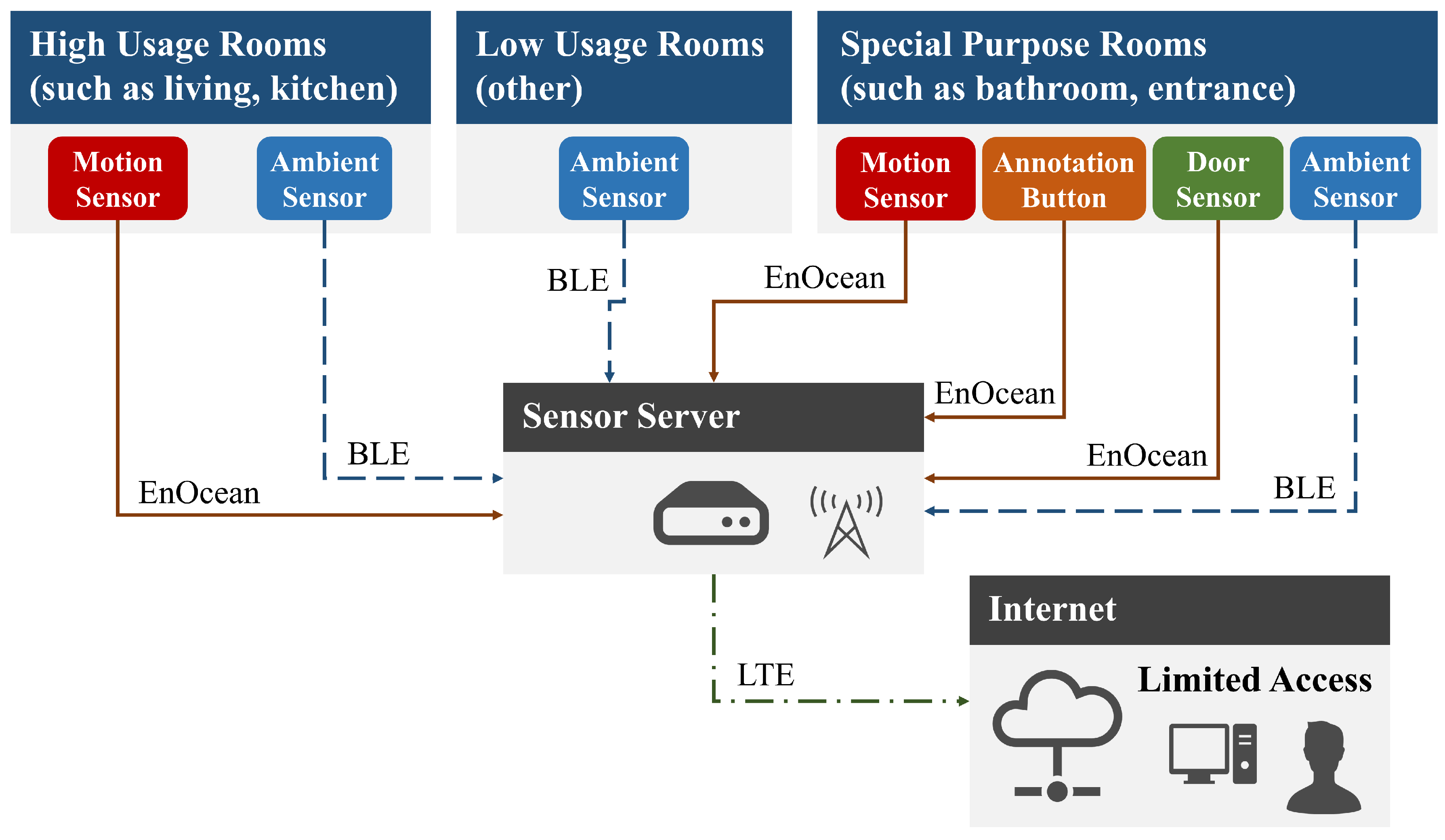
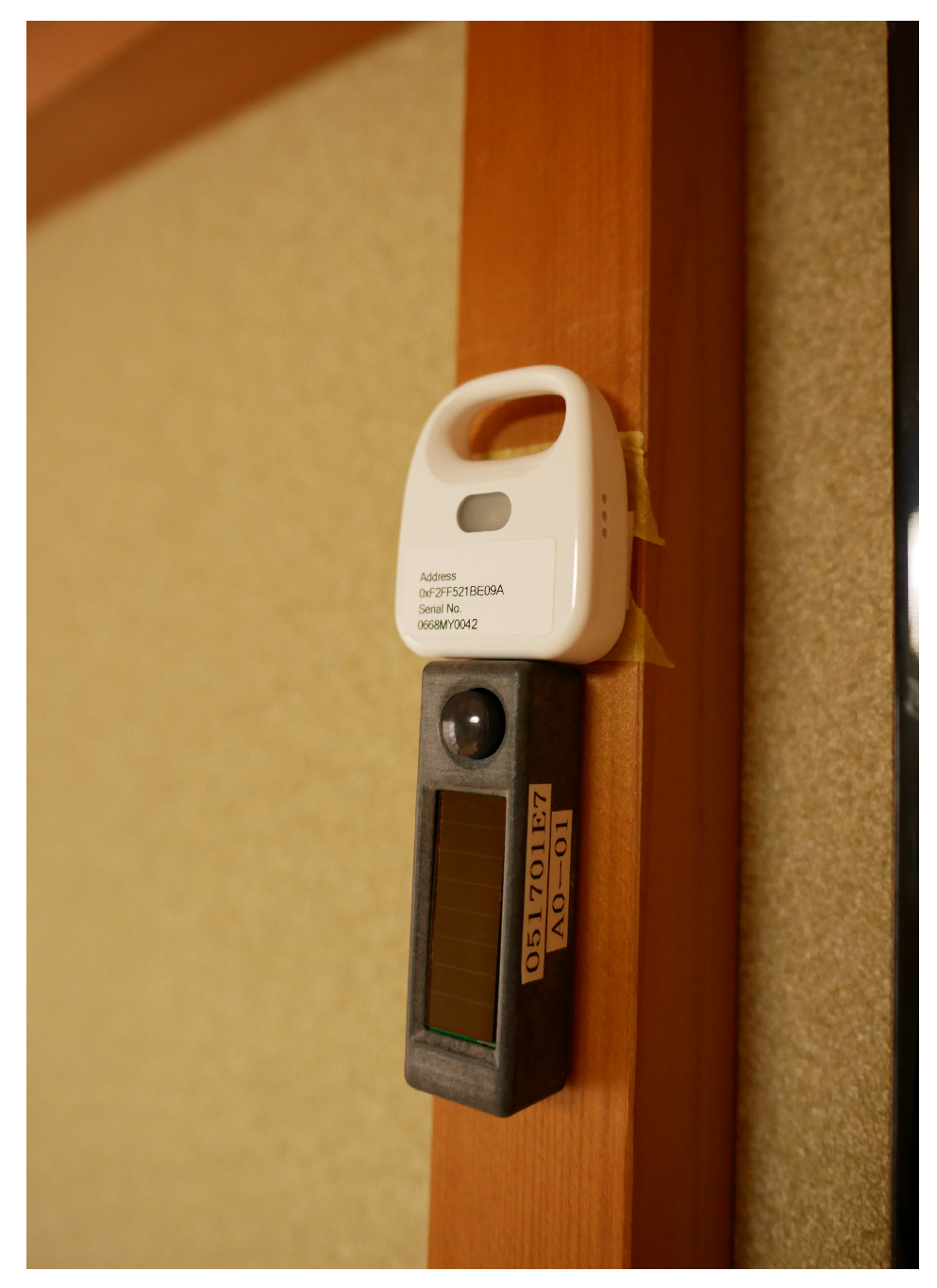
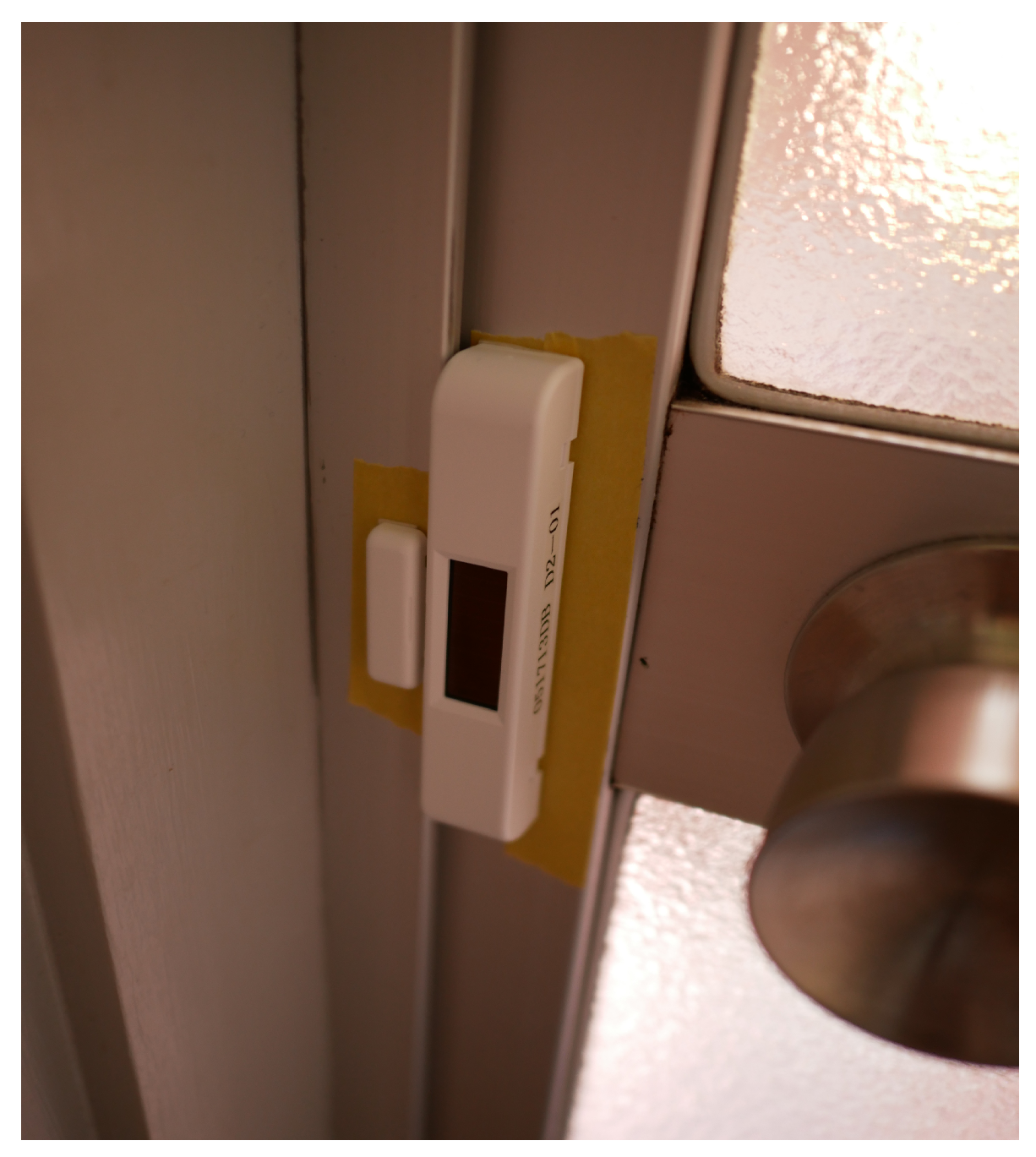
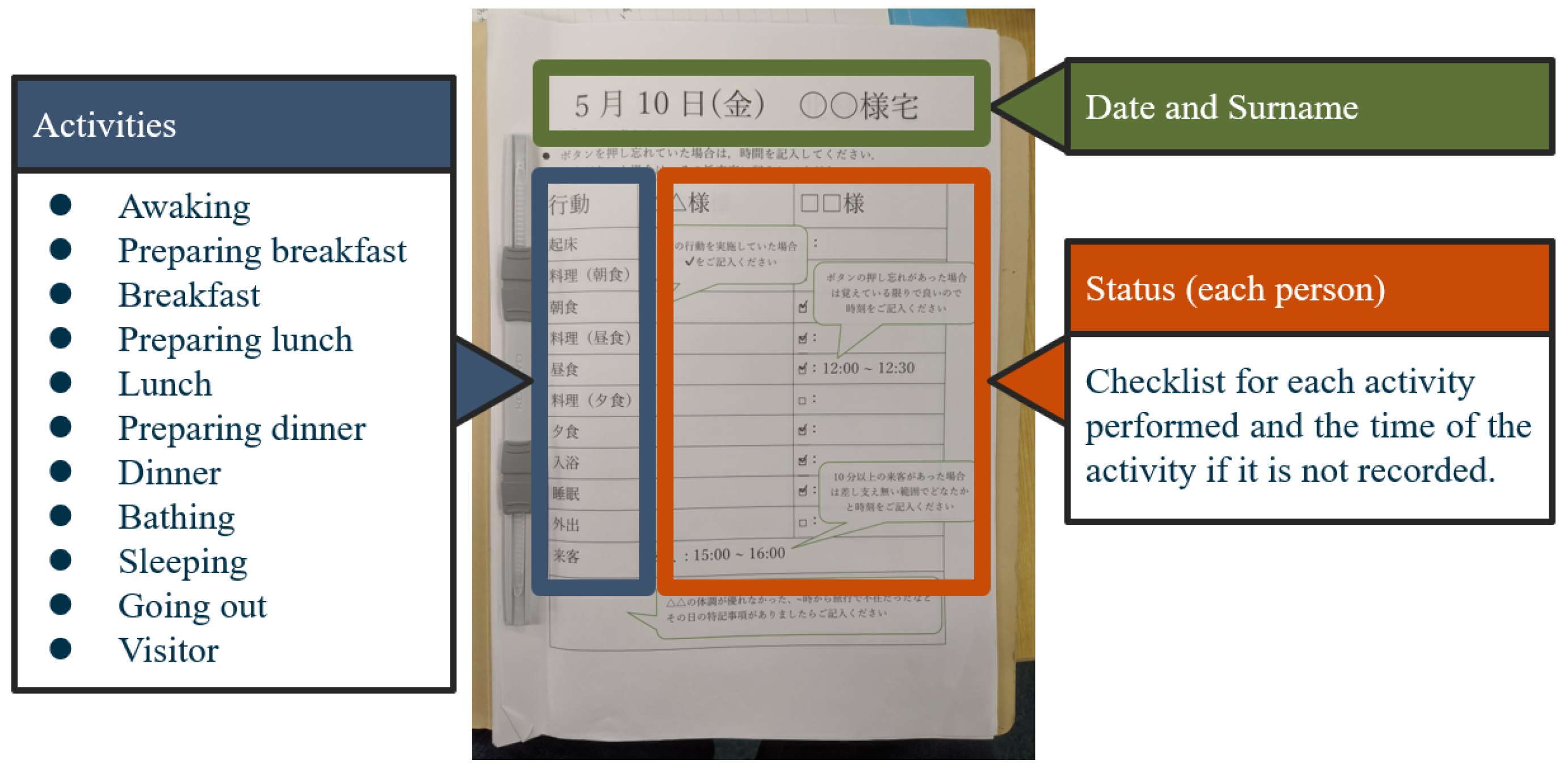

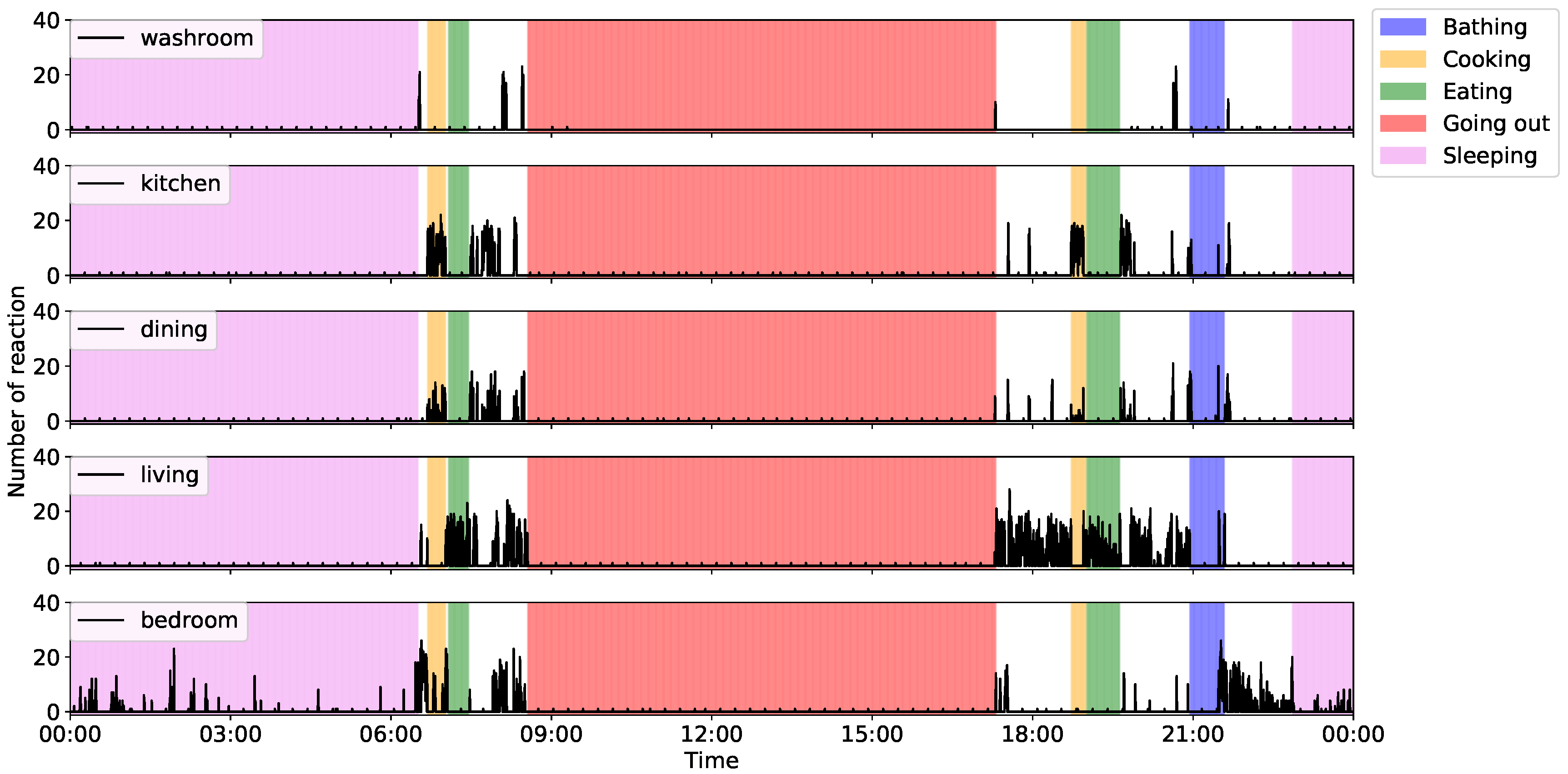
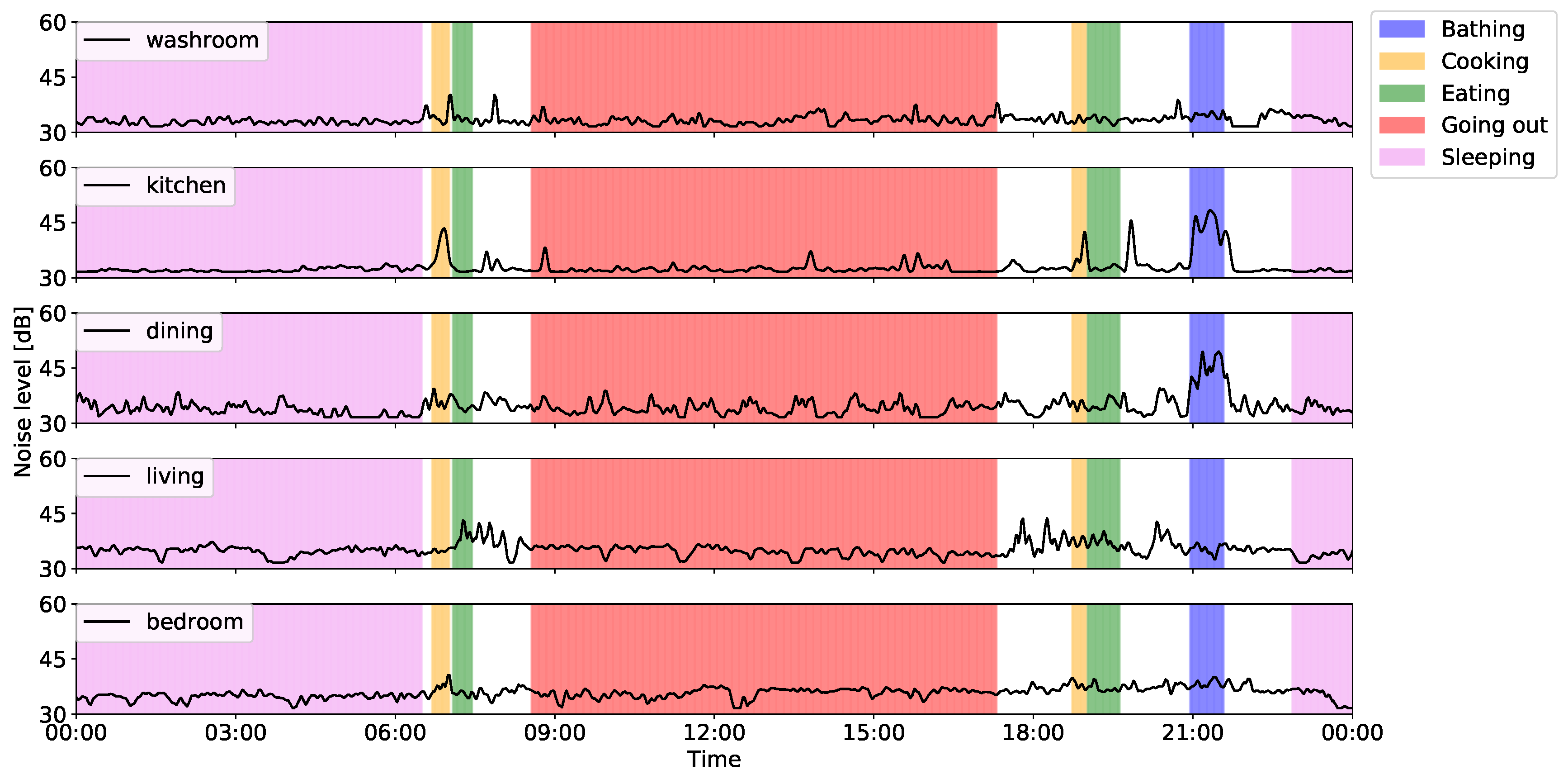

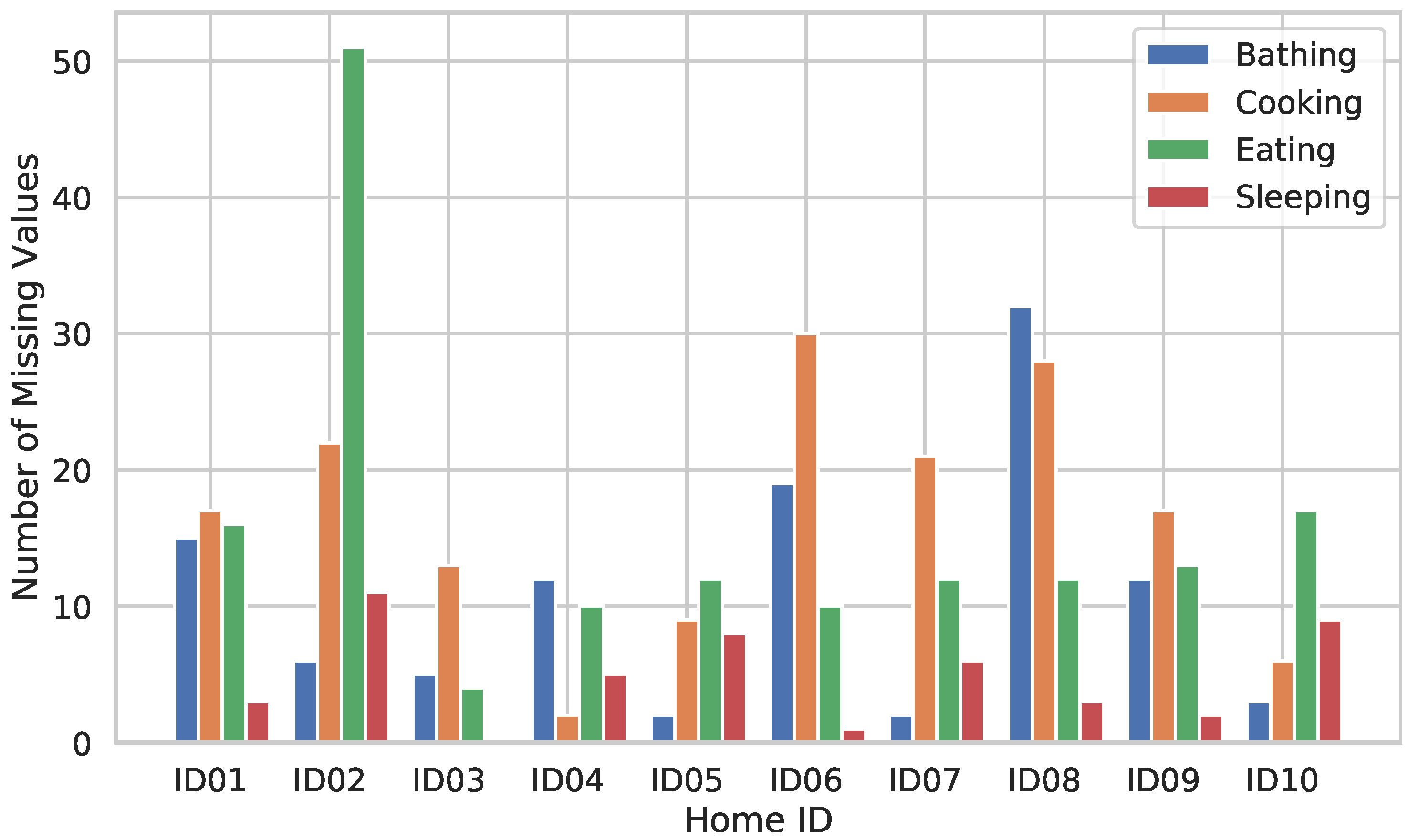
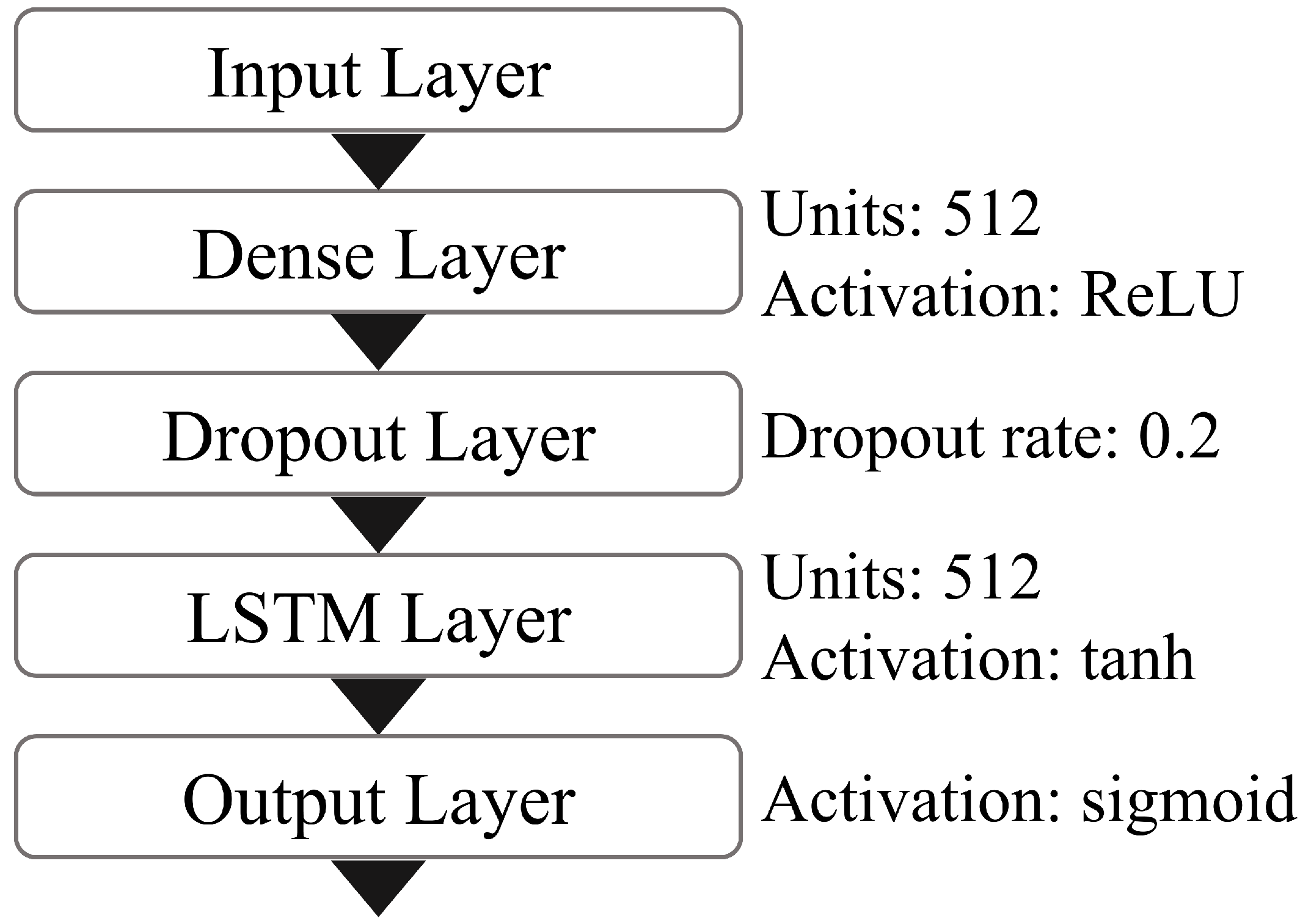
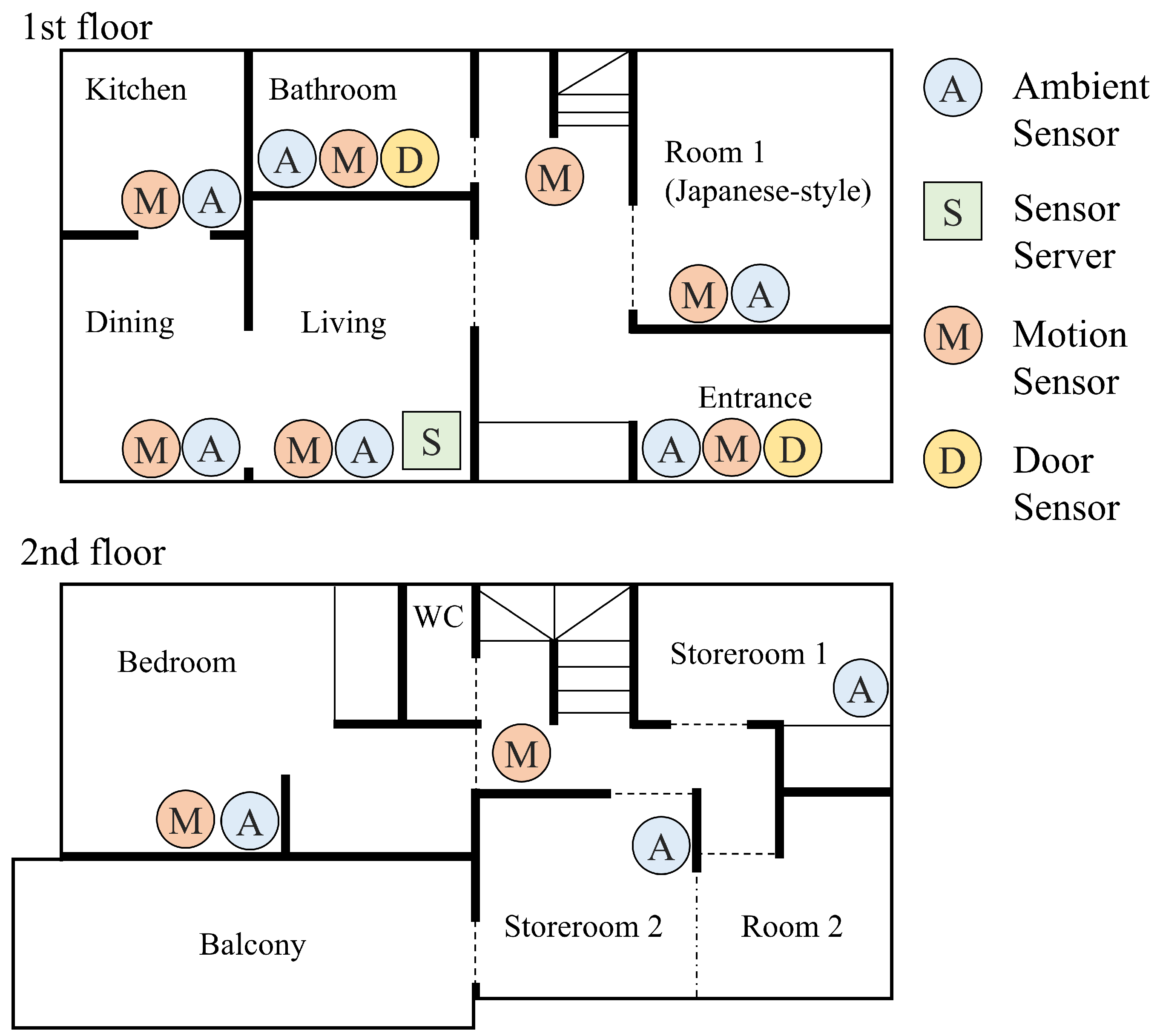
| Req. (i) | Req. (ii) | Req. (iii) | Req. (iv) | Req. (v) | |
|---|---|---|---|---|---|
| Kasteren [8] | ✓ | ✓ | ✓ | △ | n/a |
| ARAS [9] | ✓ | n/a | ✓ | △ | n/a |
| Placelab [12] | ✓ | ✓ | ✓ | △ | n/a |
| Domus [13] | n/a | n/a | n/a | n/a | n/a |
| Sweet Home [14] | n/a | n/a | n/a | n/a | n/a |
| CASAS SHiB [15] | ✓ | ✓ | ✓ | △ | n/a |
| SPHERE [53] | ✓ | n/a | △ | △ | △ |
| Our System | ✓ | ✓ | ✓ | ✓ | ✓ |
| Number of Residents | Motion Sensors | Ambient Sensors | Door Sensors | Guests | Pet | Remarks | |
|---|---|---|---|---|---|---|---|
| ID01 | 2 | 10 | 10 | 0 | Often: grandchild, friend | No | - |
| ID02 | 2 | 8 | 7 | 0 | Few or no | No | Sometimes bathing at health club. |
| ID03 | 2 | 10 | 10 | 1 | Few or no | No | - |
| ID04 | 2 | 9 | 9 | 1 | Few or no | Cat | One resident is woman in her 30 s. |
| ID05 | 1 | 10 | 10 | 2 | Few or no | No | - |
| ID06 | 2 | 10 | 10 | 2 | Often: grandchild | No | Grandchildren perform activities such as bathing or eating. |
| ID07 | 1 | 6 | 7 | 1 | Often: child | No | Bad communication signal because of reinforced concrete. |
| ID08 | 2 | 10 | 10 | 0 | Sometimes | No | Sometimes guest stays overnight. |
| ID09 | 2 | 10 | 10 | 2 | Few or no | Cat | - |
| ID10 | 1 | 6 | 7 | 2 | Rarely: caregiver | No | Regular caregiver visits. |
| Activity | ID01 | ID02 | ID03 | ID04 | ID05 | ID06 | ID07 | ID08 | ID09 | ID10 | Ave. |
|---|---|---|---|---|---|---|---|---|---|---|---|
| Bathing | 22.9% | 22.6% | 71.4% | 11.8% | 37.7% | 32.5% | 5.8% | 207.8% | 24.5% | 10.1% | 44.7% |
| Cooking | 21.7% | 48.2% | 15.2% | 18.3% | 14.8% | 33.1% | 24.9% | 12.5% | 32.1% | 10.1% | 23.1% |
| Eating | 5.0% | 29.9% | 26.1% | 23.4% | 29.1% | 3.6% | 19.7% | 11.7% | 24.7% | 31.4% | 20.5% |
| Sleeping | 1.0% | 11.4% | 0.0% | 8.3% | 24.0% | 19.4% | 13.6% | 10.1% | 16.9% | 26.9% | 13.4% |
| Activity | Precision | Recall | F Measure | Precision SD | Recall SD |
|---|---|---|---|---|---|
| Bathing | 0.249 | 0.711 | 0.306 | 0.2628 | 0.2843 |
| Cooking | 0.212 | 0.850 | 0.310 | 0.1310 | 0.1547 |
| Eating | 0.198 | 0.549 | 0.254 | 0.1487 | 0.3053 |
| Going out | 0.351 | 0.720 | 0.424 | 0.2746 | 0.2828 |
| Sleeping | 0.824 | 0.787 | 0.740 | 0.2207 | 0.2486 |
| Total avg. | 0.367 | 0.723 | 0.407 | 0.2076 | 0.2551 |
| Concept | Sensor Installation | Annotation | Target Activity | Environment/Data | Algorithm/Result | |
|---|---|---|---|---|---|---|
| Kasteren [8] | A smart home kit for high quality annotation. | • Digital sensors (Binary sensors) × 14. Installation time: N/A | Bluetooth Headset | Leave house, Toileting, Showering, Sleeping, Preparing breakfast, Preparing dinner, Preparing beverage. | Sensing term: 28 days Field: N/A (just a room) Number of participants: 1 Number of residents: 1 | Algorithm: HMM, CRF Result: Accuracy with HMM—94.5% Accuracy with CRF—95.6% |
| ARAS [9] | A smart home kit for households with multiple residents. | • Force sensitive resistors • Pressure mats • Contact sensors • Proximity sensors • Sonar distance sensors • Photocells • Temperature sensors • IR receivers Installation time: N/A | Software on PC | Many activities (26 types). However, in the analysis, authors consider only 6 activities. Sleeping, Eating, Personal hygiene, Going out, Relaxing, Others. | Sensing term: 2 months Field: N/A (just a room) Number of participants: 4 Number of residents: 2 | House A: Algorithm: HMM Result: Accuracy—61.5% Cross validation House B: Algorithm: HMM Result: Accuracy—76.2% Cross validation. |
| Placelab [12] | A smart home kit with small/simple state change sensors. | • State change sensors (×77 for Participant 1, and ×84 for Participant 2.) Installation time: 3 h | Software on PDA | Many activities. However, most of them were not performed. (Participant 1) Preparing lunch, Toileting, Preparing breakfast, Bathing, Dressing, Grooming, Preparing a beverage, Doing Laundry. (Participant 2) Preparing lunch, Listening to music, Toileting, Preparing breakfast, Washing dishes, Watching TV. | Sensing term: 14 days Field: N/A (just a room) Number of participants: 2 Number of residents: 1 | Participant 1: Algorithm: NB Result: Accuracy—64.3% Participant 2: Algorithm: NB Result: Accuracy—50.8% |
| Sweet home [14] /Domus [13] | Multimodal dataset for appliances control using voice in smart home. | • Switch sensor × 8 • Door contact × 6 • PID IR × 2 • Microphone × 7 Installation time: N/A | Software on PC | Sleeping, Resting Dressing/undressing, Preparing a meal, Having a meal, Doing a laundry, Hygiene activity | Sensing term: 3 h~6 h Field: Smart home Number of participants: 11~23 Number of residents: N/A | Algorithm: MLN, SVM, NB Result: Accuracy with MLN—85.3% Accuracy with SVM—59.6% Accuracy with NB—66.1% |
| CASAS [15] | A smart home kit that can be expanded with minimal effort. | • Motion/Light sensor × 24 • Door sensor × 1 • Relay × 2 • Temperature × 2 and more sensors depending on dataset. Installation time: Just over 1 h. | Software on PC | Bed-toilet transition, Cook, Eat, Enter home, Leave home, Personal hygiene, Phone, Relax, Sleep, Work. | Sensing term: 1 month Field: Smart Apart Number of participants: 18 Number of residents: 1 | Algorithm: SVM Result: F measure—58.9% 5-fold cross validation. |
| Our Study | A smart house kit for the elderly in ordinary households. | • Motion sensors × 10 (maximum) • Ambient sensors × 10 (maximum) • Door sensors × 2 (maximum) Installation time: approximately 45 min | Pushbuttons × 5 (for each activity) | Bathing, Cooking, Eating, Going out, Sleeping | Sensing term: 2 months Field: Ordinary Home Number of participants: 17 Number of residents: 1 or 2 | Algorithm: LSTM Result: F measure—40.7% Holdout validation |
© 2020 by the authors. Licensee MDPI, Basel, Switzerland. This article is an open access article distributed under the terms and conditions of the Creative Commons Attribution (CC BY) license (http://creativecommons.org/licenses/by/4.0/).
Share and Cite
Matsui, T.; Onishi, K.; Misaki, S.; Fujimoto, M.; Suwa, H.; Yasumoto, K. SALON: Simplified Sensing System for Activity of Daily Living in Ordinary Home. Sensors 2020, 20, 4895. https://doi.org/10.3390/s20174895
Matsui T, Onishi K, Misaki S, Fujimoto M, Suwa H, Yasumoto K. SALON: Simplified Sensing System for Activity of Daily Living in Ordinary Home. Sensors. 2020; 20(17):4895. https://doi.org/10.3390/s20174895
Chicago/Turabian StyleMatsui, Tomokazu, Kosei Onishi, Shinya Misaki, Manato Fujimoto, Hirohiko Suwa, and Keiichi Yasumoto. 2020. "SALON: Simplified Sensing System for Activity of Daily Living in Ordinary Home" Sensors 20, no. 17: 4895. https://doi.org/10.3390/s20174895





